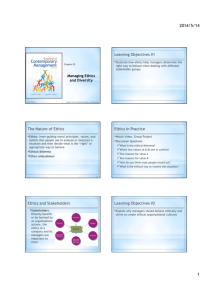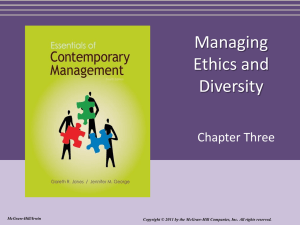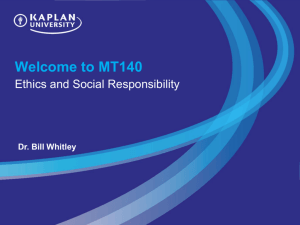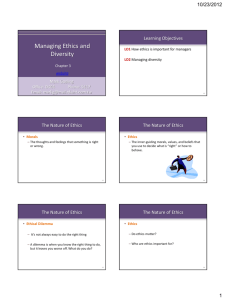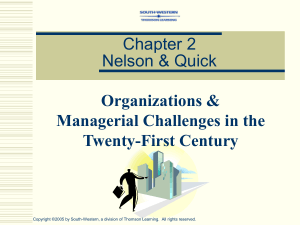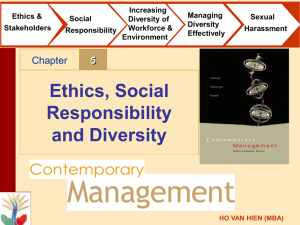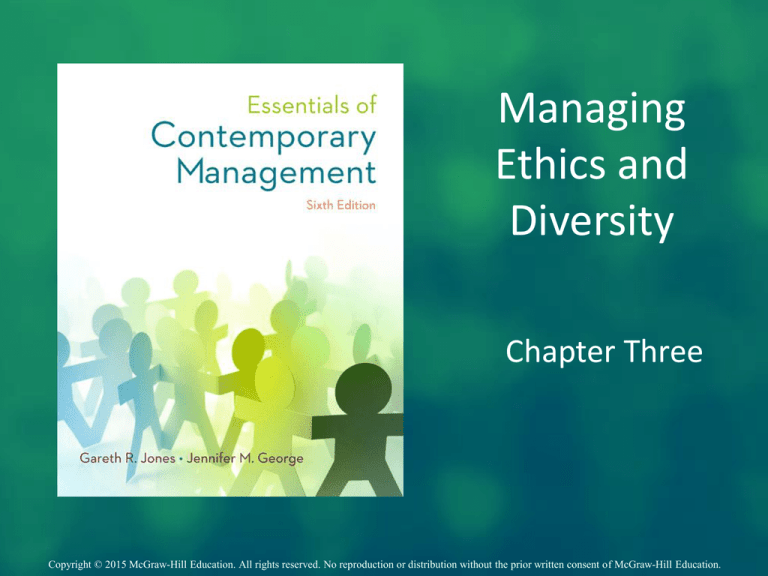
Managing
Ethics and
Diversity
Chapter Three
Copyright © 2015 McGraw-Hill Education. All rights reserved. No reproduction or distribution without the prior written consent of McGraw-Hill Education.
3-1
Learning Objectives
LO3-1 Illustrate how ethics help managers
determine the right way to behave when
dealing with different stakeholder groups
LO3-2 Explain why managers should behave
ethically and strive to create ethical
organizational cultures
LO3-3 Appreciate the increasing diversity of the
workforce and of the organizational
environment
3-2
Learning Objectives (cont.)
LO3-4 Grasp the central role that managers play
in the effective management of diversity
LO3-5 Understand why the effective
management of diversity is both an
ethical and a business imperative
LO3-6 Understand the two major forms of sexual
harassment and how they can be
eliminated
3-3
The Nature of Ethics
Ethics
The inner-guiding
moral principles,
values, and beliefs
that people use to
analyze or interpret a
situation and then
decide what is the
“right” or appropriate
way to behave
3-4
Types of Company Stakeholders
Figure 3.1
3-5
Four Ethical Rules
Figure 3.2
3-6
Practical Decision Model
1. Does my decision fall within the acceptable
2.
3.
standards that apply in business today?
Am I willing to see the decision
communicated to all people and groups
affected by it?
Would the people with whom I have a
significant personal relationship approve of
the decision?
3-7
Figure 3.3
Some Effects of
Ethical/Unethical
Behavior
3-8
Why should managers
behave ethically?
Trust
Willingness of one
person or group to
have faith or
confidence in another
person’s goodwill,
even though this puts
them at risk
Reputation
Esteem or high
repute that
individuals or
organizations gain
when they behave
ethically
3-9
Determinants of Ethics
Figure 3.4
3-10
The Increasing Diversity of the
Workforce and the Environment
Diversity
Differences among people due to age, gender,
race, ethnicity, religion, sexual orientation,
socioeconomic background, education, physical
appearance, capabilities, disabilities, and any
other characteristic used to distinguish people.
3-11
Sources of Diversity in the Workplace
Figure 3.5
3-12
Workforce Diversity:
Capabilities and Disabilities
Disability Issues
Providing reasonable accommodations for
individuals with disabilities
Promoting a nondiscriminatory workplace
environment
Educating the organization about disabilities
3-13
Forms of Sexual Harassment
Quid pro quo
Asking for or forcing an employee to perform
sexual favors in exchange for receiving some
reward or avoiding negative consequences.
3-14
Forms of Sexual Harassment
Hostile work environment
Telling lewd jokes, displaying pornography, making
sexually oriented remarks about someone’s
personal appearance, and other sex-related
actions that make the work environment
unpleasant.
3-15


